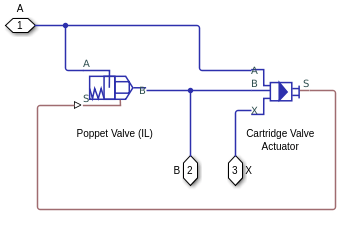Cartridge Valve Insert (IL)
Cartridge flow-control valve in an isothermal liquid network
Libraries:
Simscape /
Fluids /
Isothermal Liquid /
Valves & Orifices /
Flow Control Valves
Description
The Cartridge Valve Insert (IL) block models a cartridge flow-control valve in an isothermal liquid network. The valve seat can be specified as conical or as a custom opening parameterized by analytical or tabular formulations. The valve opens when the combined pressures at ports A and B exceed the Spring preload force and pressure at port X.
You can specify the block seat geometry as either conical or a custom. This seat setting determines the sub-components that make up the block. In both configurations, the Port A poppet to port X pilot area ratio parameter sets the force ratio in the underlying Cartridge Valve Actuator block.
Use the Cartridge Valve Insert (IL) block when you would like flow control set by a pilot pressure line. Use the Pressure-Compensated 3-Way Flow Control Valve (IL) or Pressure-Compensated Flow Control Valve (IL) block for flow control due to a pressure differential or the Poppet Valve (IL) block for valve opening controlled by an external physical signal.
Conical Valve Seat
The conical cartridge valve insert is a composite of two Isothermal Liquid library blocks:
Conical Cartridge Valve Insert Schematic

Custom Valve Seat
The custom cartridge valve insert is a composite of two Isothermal Liquid library blocks:
Custom Cartridge Valve Insert Schematic

In the custom configuration, you can parameterize the valve opening analytically or with a data set.
By setting Orifice parameterization to
Linear - area vs. control member position, the
valve opening area is linearly proportional to the poppet position. Once the
pressure at port A or B exceeds the
Spring preload force, the valve opens until the
Maximum orifice area is reached. When the valve is
fully closed, a small Leakage area remains open to flow so
that numerical continuity is maintained in the network.
By setting Orifice parameterization to Tabulated data -
Area vs. control member position, you can supply the opening
profile based on opening area and poppet position. The block queries between
data points with linear interpolation and uses nearest extrapolation for points
beyond the table boundaries.
By setting Orifice parameterization to Tabulated data -
Volumetric flow rate vs. control member position and pressure
drop, you can supply the volumetric flow rate through the
valve as a parameterized table of poppet position and valve pressure drop. The
block queries between data points with linear interpolation and uses linear
extrapolation for points beyond the table boundaries. The volumetric flow rate
is converted to a mass flow rate by multiplying by the fluid density.
Opening Dynamics
If opening dynamics are modeled, a lag is introduced to the flow response to the modeled control pressure. pcontrol becomes the dynamic control pressure, pdyn; otherwise, pcontrol is the steady-state pressure. The instantaneous change in dynamic control pressure is calculated based on the Opening time constant, τ:
By default, Opening dynamics is set to
Off.
Numerically-Smoothed Force and Opening
When the actuator is close to full extension or full retraction, and
Orifice parameterization is set to Linear -
area vs. control member position, you can maintain numerical
robustness in your simulation by adjusting the block Smoothing
factor. A smoothing function is applied to the actuator force and
orifice opening or area, but primarily influences the simulation at the extremes of
these ranges.
The normalized force that opens the valve is
where:
FA is the force at port A.
FB is the force at port B.
FPreload is the Spring preload force.
FPilot is the force at port X.
When Valve seat specification is set to
Conical, the block smoothly saturates the orifice
opening distance between 0 and the maximum orifice opening
distance. When Valve seat specification is set to
Custom, the block smoothly saturates the valve
opening area between the Leakage area parameter and the
Maximum orifice area parameter.
For more information, see Numerical Smoothing.
Examples
Ports
Conserving
Parameters
Extended Capabilities
Version History
Introduced in R2020a

